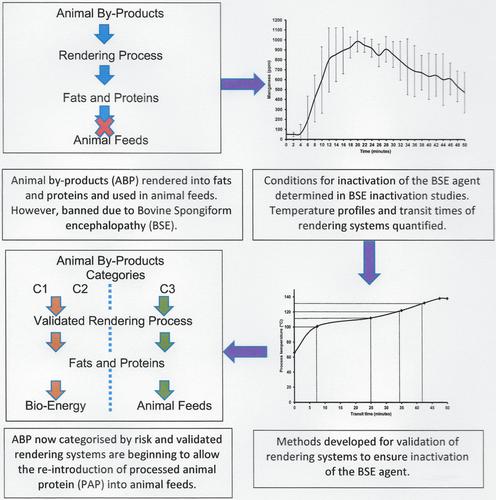当前位置:
X-MOL 学术
›
Ann. Appl. Biol.
›
论文详情
Our official English website, www.x-mol.net, welcomes your
feedback! (Note: you will need to create a separate account there.)
The role of rendering in relation to the bovine spongiform encephalopathy epidemic, the development of EU animal by‐product legislation and the reintroduction of rendered products into animal feeds
Annals of Applied Biology ( IF 2.2 ) Pub Date : 2021-01-20 , DOI: 10.1111/aab.12676 S. Woodgate 1 , R. Wilkinson 2
Annals of Applied Biology ( IF 2.2 ) Pub Date : 2021-01-20 , DOI: 10.1111/aab.12676 S. Woodgate 1 , R. Wilkinson 2
Affiliation

|
The bovine spongiform encephalopathy (BSE) epidemic in 1986 highlighted the importance of the rendering industry as a key component of the food supply chain. Prior to 1986 the rendering industry was poorly understood. However, following the emergence of BSE research was commissioned to characterise rendering systems and investigate their ability to inactivate transmissible spongiform encephalopathy (TSE) agents. Six rendering systems were found to be operational in Europe but their key process parameters, such as particle size, process temperature and transit time, were poorly characterised. This review describes how these key process parameters were determined and used to inform protocols for the subsequent TSE inactivation trials which subsequently shaped both EU legislation and the development of techniques used to validate rendering systems. It also describes how EU legislation banning the use of animal‐derived proteins in animal feeds ('feed ban') effectively eliminated the market for meat and bone meal (MBM) and how the rendering industry sought to 'add value' to rendered products by conducting research to support the development of new markets for rendered products. The nutritional, environmental and economic characteristics of modern processed animal proteins (PAPs) mean that they represent valuable ingredients for use in animal feeds. Recent research has paved the way for legislative changes allowing the safe reintroduction of nonruminant PAP into aqua‐feeds and may soon facilitate their reintroduction into pig and poultry feeds. However, resistance from key stakeholders in the food chain remains a significant challenge that must be overcome before their full potential can be realised. Further research is required to characterise modern PAPS and to ensure their appropriate, safe and acceptable inclusion in animal feeds.
中文翻译:

提炼在牛海绵状脑病流行,欧盟动物副产品法规的制定以及提炼产品重新引入动物饲料中的作用
1986年的牛海绵状脑病(BSE)疫情凸显了提炼业作为食品供应链的关键组成部分的重要性。在1986年之前,对绘画行业的了解很少。然而,随着疯牛病的出现,委托研究来表征提炼系统并研究其灭活可传播海绵状脑病(TSE)药剂的能力。发现有六个提炼系统可在欧洲运行,但其关键工艺参数(例如粒度,工艺温度和运输时间)的特征较差。这篇综述描述了如何确定这些关键工艺参数,并将其用于随后的TSE灭活试验的方案,该试验随后影响了欧盟立法和用于验证提炼系统的技术的发展。它还描述了欧盟立法如何禁止在动物饲料中使用动物源性蛋白质(“饲料禁令”)如何有效地消除了肉骨粉市场(MBM),以及提炼业如何通过以下方式设法为提炼产品“增值”进行研究,以支持提炼产品的新市场的发展。现代加工动物蛋白(PAP)的营养,环境和经济特征意味着它们代表了用于动物饲料的宝贵成分。最近的研究为立法改革铺平了道路,允许将非反刍动物的PAP安全地重新引入水产饲料中,并可能很快促进它们被重新引入猪和禽类饲料中。然而,食品链中主要利益相关者的抵制仍然是一项重大挑战,必须先克服这些挑战,才能充分发挥其潜力。需要进一步研究以鉴定现代PAPS的特征,并确保将其适当,安全和可接受地包含在动物饲料中。
更新日期:2021-01-20
中文翻译:

提炼在牛海绵状脑病流行,欧盟动物副产品法规的制定以及提炼产品重新引入动物饲料中的作用
1986年的牛海绵状脑病(BSE)疫情凸显了提炼业作为食品供应链的关键组成部分的重要性。在1986年之前,对绘画行业的了解很少。然而,随着疯牛病的出现,委托研究来表征提炼系统并研究其灭活可传播海绵状脑病(TSE)药剂的能力。发现有六个提炼系统可在欧洲运行,但其关键工艺参数(例如粒度,工艺温度和运输时间)的特征较差。这篇综述描述了如何确定这些关键工艺参数,并将其用于随后的TSE灭活试验的方案,该试验随后影响了欧盟立法和用于验证提炼系统的技术的发展。它还描述了欧盟立法如何禁止在动物饲料中使用动物源性蛋白质(“饲料禁令”)如何有效地消除了肉骨粉市场(MBM),以及提炼业如何通过以下方式设法为提炼产品“增值”进行研究,以支持提炼产品的新市场的发展。现代加工动物蛋白(PAP)的营养,环境和经济特征意味着它们代表了用于动物饲料的宝贵成分。最近的研究为立法改革铺平了道路,允许将非反刍动物的PAP安全地重新引入水产饲料中,并可能很快促进它们被重新引入猪和禽类饲料中。然而,食品链中主要利益相关者的抵制仍然是一项重大挑战,必须先克服这些挑战,才能充分发挥其潜力。需要进一步研究以鉴定现代PAPS的特征,并确保将其适当,安全和可接受地包含在动物饲料中。











































 京公网安备 11010802027423号
京公网安备 11010802027423号